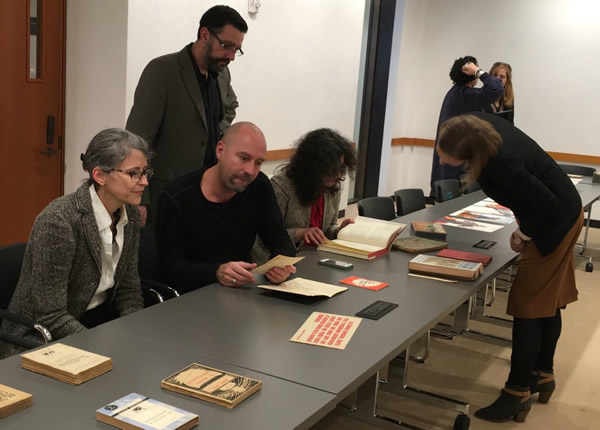The aesthetics of youth in modernist Spain
 Leslie Harkema’s opening remarks pronounced the colloquium’s central idea: for the Modernist writers of early-20th-century Spain, “youth was the common denominator.” Unlike 19th-century youths, who affected being older, these writers wanted to prolong their adolescence. Driven to “make it young,” to adapt Ezra Pound’s dictum, they composed works of “young literature” (“joven literatura”). This movement spanned generations: even some fin-de-siècle writers, like Miguel de Unamuno and Pío Baroja, entered into the youthful aesthetics, to join the effort to regenerate Spanish culture.
Leslie Harkema’s opening remarks pronounced the colloquium’s central idea: for the Modernist writers of early-20th-century Spain, “youth was the common denominator.” Unlike 19th-century youths, who affected being older, these writers wanted to prolong their adolescence. Driven to “make it young,” to adapt Ezra Pound’s dictum, they composed works of “young literature” (“joven literatura”). This movement spanned generations: even some fin-de-siècle writers, like Miguel de Unamuno and Pío Baroja, entered into the youthful aesthetics, to join the effort to regenerate Spanish culture.
To discuss this literature, scholars from around the country gathered on November 4-5, for the colloquium, “The Aesthetics of Youth in Modernist Spain,” organized by Leslie Harkema (Yale, Spanish and Portuguese) and Nicolás Fernández-Medina (Penn State, Spanish and Italian). After the opening remarks, an Objects Session at the Beinecke whetted attendees’ Modernist interest. Modern European Curator Kevin Repp laid out dozens of first editions, photographs, manuscripts, and pamphlets from the Langston Hughes and Marinetti Papers and other holdings. A highlight was Langston Hughes’s typed, hand-corrected translation of García Lorca’s Blood Wedding.
On the second day, four sessions at the Whitney Humanities Center considered themes in the aesthetics of youth. Opening the first session, “Youth and Generation,” C. Christopher Soufas (Temple) identified the ideology of early 20th-c. Spanish literary critics in crafting the idea of “generations” of 19th-to-20th-c. authors. Soufas traced this generational model, which replaced the “antiquated concept” of transnational movements (e.g., Romanticism), to proto-fascist German literary criticism. Juan Herrero-Senés (U.C. Boulder) proposed four representations of youths in Spanish Modernism: as ironic-introverted (tedious), excited-extroverted (empty), activist (happiness depends on collective success), and the despotic (“fascination with power, strength, and heroism”).
The second session, “Body and Self,” explored Modernist preoccupations with the self and its vitality. Alberto Medina (Columbia) sought the origins of the withdrawal from politics, despite a “politics of the self.” Using the lens of then-influential anarchist pedagogy, he proposed that the move toward “egolatry” after the Great War is politicizing aesthetics, resisting history and war’s presence and introducing revolution by removing politics. Fernández-Medina then described the literary focus on a “lived body” with what he called “vital force:” pain and suffering bring a person the conscious knowledge of life, and even in suicide, the “lifeless body is an indictment of the present, and an appeal to the future.”
The third session, “Gender and Narrative,” confronted a fraught issue in a male-dominated Modernist literature. Susan Larson (Texas Tech), starting from the avant-garde appeal for “macho” and not “hermaphroditic” authors, identified struggles between the writer and feminized institutions. For her, “the text and the body of the character are unreadable,” still to be written, so “the reader is forced to fill in.” Harkema identified a change in the Bildungsroman: “personal time no longer matched up with national time,” as in the 19th century, and “protagonists never grow up,” making formation into protest. Rosa Chacel’s novels replace the traditional female suicide with an acceptance of life, and the male’s suicide instead.
In “Eros and Thanatos,” the final session, Nil Santiáñez (St. Louis University) continued with the demise of the Bildungsroman: fascist literature deploys tropes of youth, while being driven by a death-instinct. The character’s (and society’s) “traditional genesis can only be carried out by the very youth repressed by fascism,” and that genesis must come, paradoxically, in death.
Funding for this colloquium was provided by the Edward J. & Dorothy Clarke Kempf Memorial Fund, The Whitney Humanities Center, the Beinecke Rare Book and Manuscript Library, the European Studies Council, the Whitney and Betty MacMillan Center for International and Area Studies at Yale, the Department of Spanish and Portuguese at Yale, and The Spanish & Italian Modernist Studies Forum at the Pennsylvania State University.
Written by Veronica Mayer, Ph.D. candidate in Spanish.